What is Trotting for Grayling All About?
(including video below)
Trotting for Grayling is a great method of presenting a bait under a float in flowing water - and an enjoyable seasonal/winter tradition for many anglers when trout are out of season.
A relatively long rod (for positioning the line) and the ability to pay out your reel-line at the pace of the current creates a very natural presentation. The angler can also delicately slow the float down from time to time - causing the bait to flare up enticingly in the current. When done correctly, the float also provides very sensitive bite indication - which avoids the unwanted situation of fish swallowing the hook-bait.
In this article you'll find:
Basic Trotting for Grayling Tactics: Video of a Typical Trip for JP
In the video you can see a lot of the fundamental skills of trotting for grayling in action. Where it is allowed (and safe to do it!), wading the river can give a big advantage. You can see that a good, steady pace of water is ideal for the technique (as well as favoured by grayling in winter). Having a pouch on your belt to hold your hook-bait and loose-feed is pretty much essential.
The rule is that, the colder the weather - the smaller the amount of bait you throw in each time. Notice how John continues to feed the swim a little while he is playing his fish...
Checklist of skills in trotting for grayling:
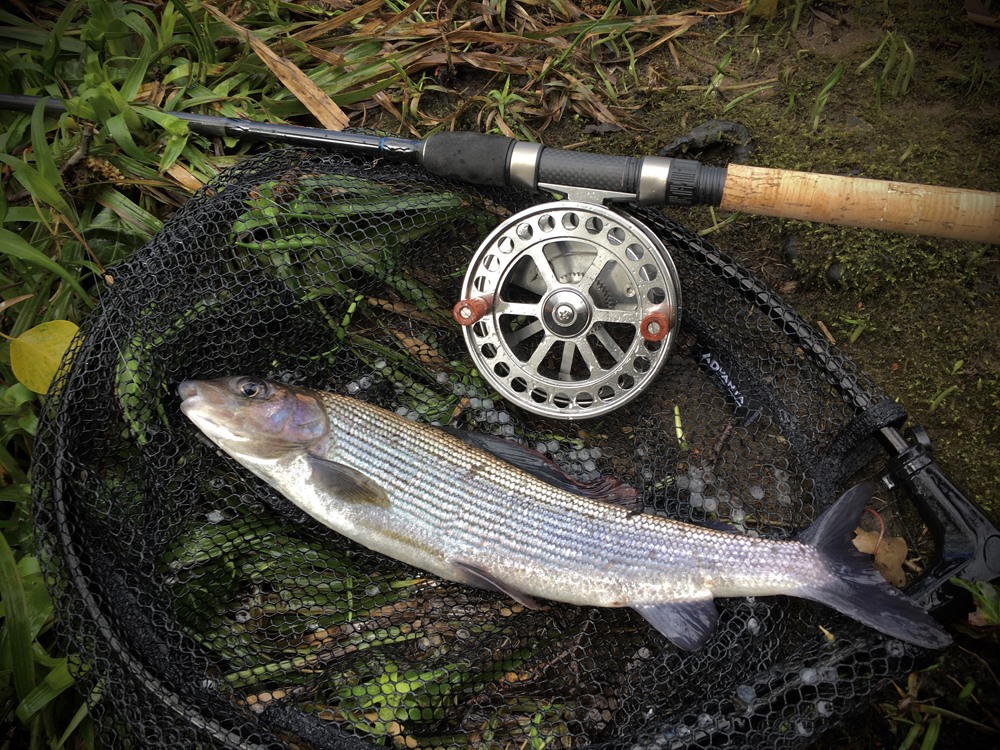
Trotting Reels
Centre pin float reels
The classic (and probably most fun) option for a trotting reel is a smooth-running centre pin. In the USA center pin reels are often called float reels. They are favoured by some trout and steelhead anglers for presenting baits under a float at the pace of the current.
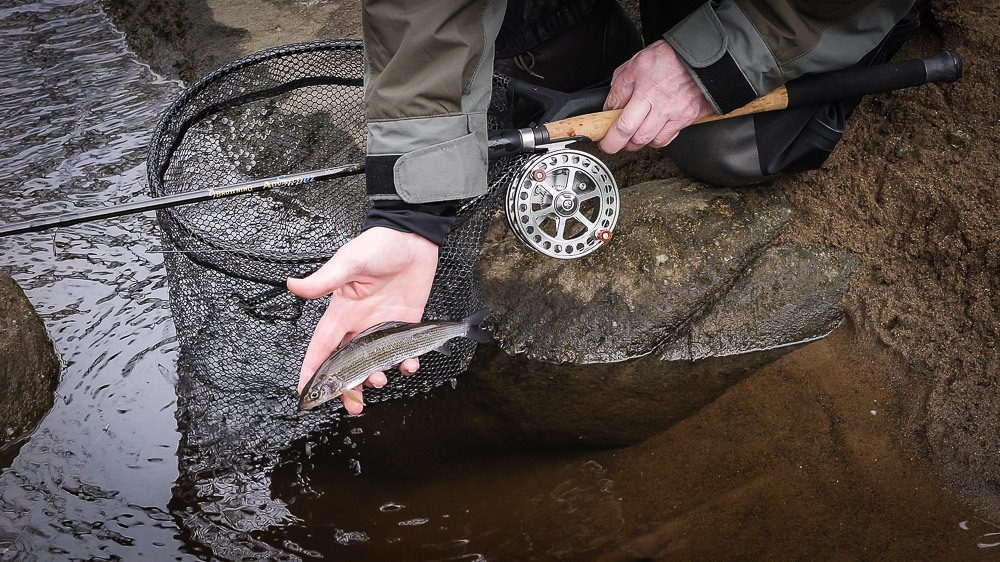
Centrepin Reel, float rod and a lovely little winter grayling
We are fortunate in the UK to have access to a wide range of price-points for these reels - with budget models that are more than capable of giving a great day's fishing. Of course, the finely-engineered top of the range models are things of beauty and really enhance the whole experience for connoisseurs.
As well as being able to set them smoothly spinning with a touch of your thumb, you have a huge degree of control over the pace of the drift. With delicate variations in thumb pressure on the rim of the reel you can fractionally slow the drift (as shown in the video) before allowing the float to continue with the current. It is just as easy to stop the reel completely and then set it re-spinning with a light touch of the thumb.
Fixed-spool reels
If you already own some float fishing tackle - and aren't sure whether you want to buy another reel just yet - it is possible to trot with a regular fixed spool reel.
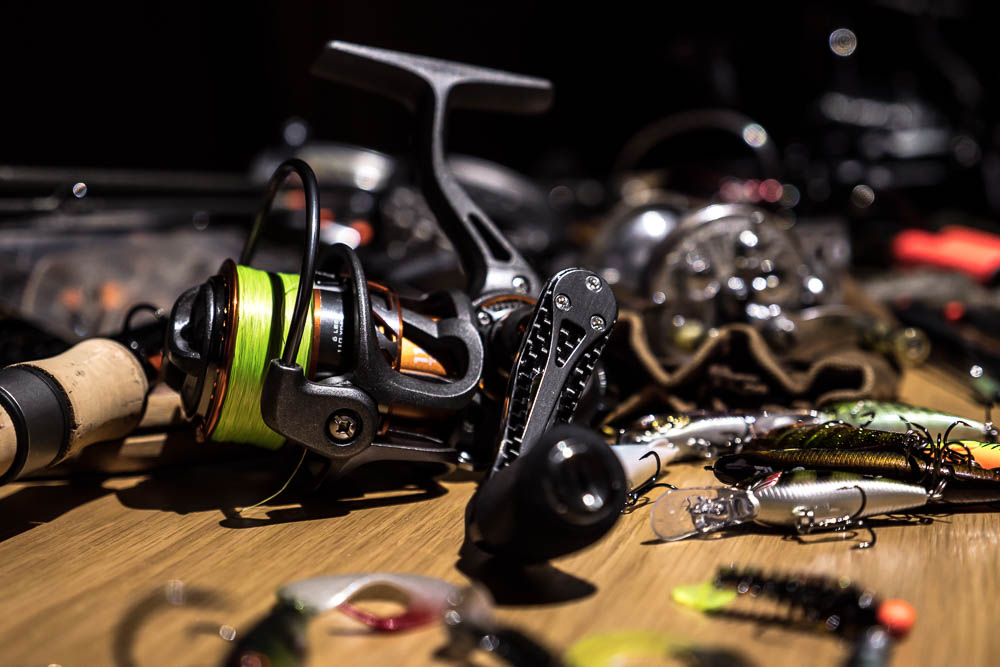
With the bale-arm open, line will easily peel off the spool (as long as it is correctly filled with line). It is also possible to have some control over the pace of the line leaving the spool. Using your index finger to "feather" the edge of the spool will slow down the line. Trapping the line against the spool with your finger, obviously, stops the float completely too. It tends to be a bit more jerky than a centre pin, but you can certainly catch fish. It is also great practice for your line-feathering skills that will help you improve your casting for all other methods of float fishing with a fixed spool reel.
Floats for trotting for grayling
The classic float to use when trotting for grayling is the stick float - which is attached to your line by stretchy silicone "float rubbers" at the top and bottom (and often also the middle) of the float. This allows you to slide the float easily up and down the line to set the depth (which you can check by using a plummet). Attaching the float this way helps keep the line on the surface - unlike waggler float fishing rigs - where the float is attached at the bottom only.
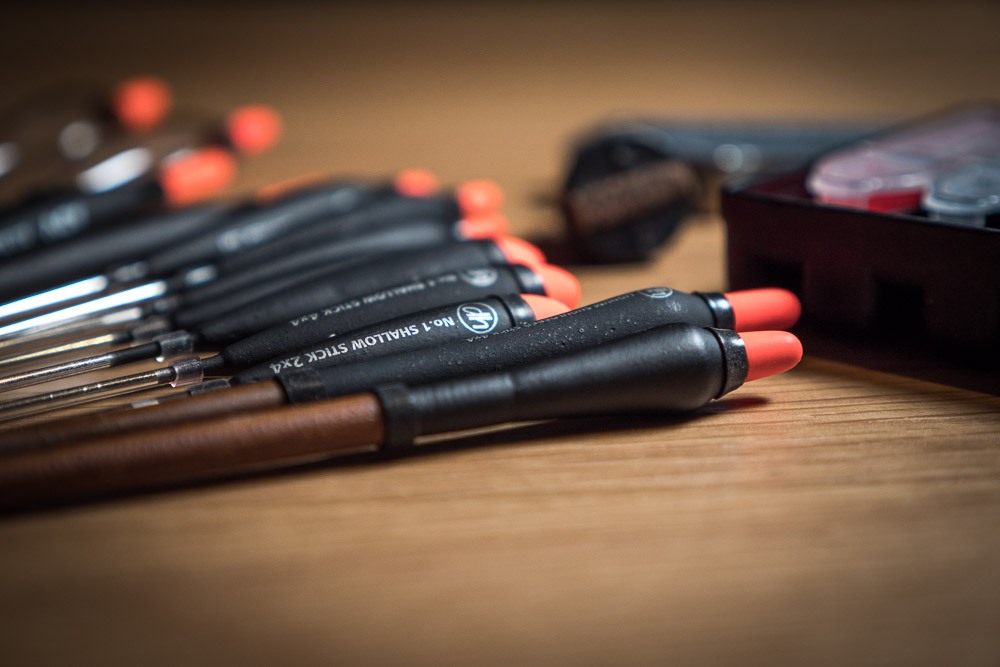
When you reel in a waggler, it will pull the float under the water. With a stick float, passing the line through the top rubber means that drawing on the line actually keeps the float on the surface. This is important when holding back the float against the flow. You don't want your float dragging under each time you do this - unless there's a fish on the end!
Stick floats are designed to have a highly buoyant top part and a lower stem that is much more dense. This creates a sturdy mass in the water and helps to produce a stable drift. Three common options for the lower, dense, portion of stick floats are wire, plastic or a dense wood - such as lignum.
The wire stems are good for cutting through turbulent water - because they have more mass for a given surface area. Wooden stems are good for steady, consistent flows - as they will be carried on a path that is more faithful to the natural current. Plastic stems can be transparent - and this could help in clear, spooky water. Solid plastic is also an easy way to add some bulk.
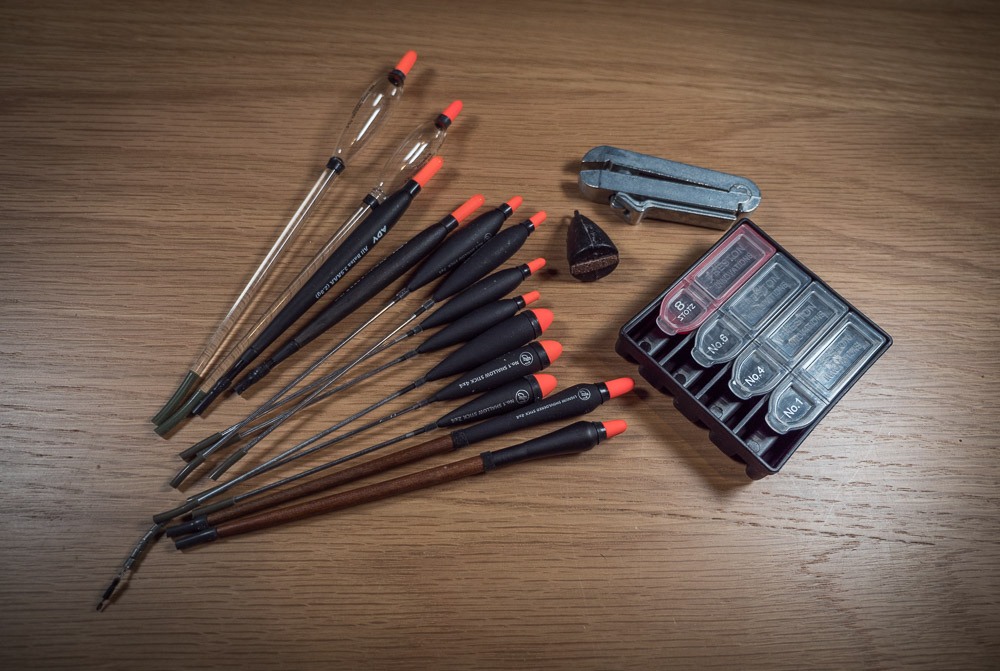
Plastic stems (upper left) wire stems (centre) and lignum stems (bottom). Note also shot dispenser, shot pliers and plummet
Size of float is mainly a matter of how much weight you need to carry in order to get your bait to the feeding depth in the current you happen to be fishing. You will want to have extra buoyancy (which will carry more weight) for holding back hard in fast flows when trotting for grayling. Beyond that, you can choose the size and shape of the top of your float based on the maximum range you want to fish. Larger tops are, obviously, visible at greater distances.
Easy Rig for Trotting for Grayling
Although there are many tricks that you can use to refine your presentation, here's a fundamental example to get you going. You can fish your reel line (see below) straight through to the hook - OR you can have a short hook-link of a lower diameter. The first thing you need to do is to thread your float rubbers onto the line hanging down from your rod tip. That will allow you to slide your float into the slightly stretchy bands of the float rubbers to hold it in place. After attaching your chosen hook (again see below), you can add the correct number of shot to cock the float and hold it down to your preferred level in the water. For sensitivity (and to prevent fish from rejecting the bait when they feel resistance), it is best to shot the float down right down so that just the tip is clear of the water surface.
Here are some basic options to choose from:
Shotting patterns when fishing for grayling
Shirt Button
Keeping things simple, you can choose between a regular "shirt-button" style of shotting. This refers to spreading your split shot at regular intervals down the line below your float. In other words, the spacing is as regular as that of the buttons running down the front of a shirt. You should try this in conditions where grayling are willing to move up in the water-column to intercept bait on the drop (i.e. as it falls through upper and middle layers of water). With zero holding back - and a smooth pay-out of line - the float will tend to drift downstream ahead of the hook. This creates very good sensitivity to bites.
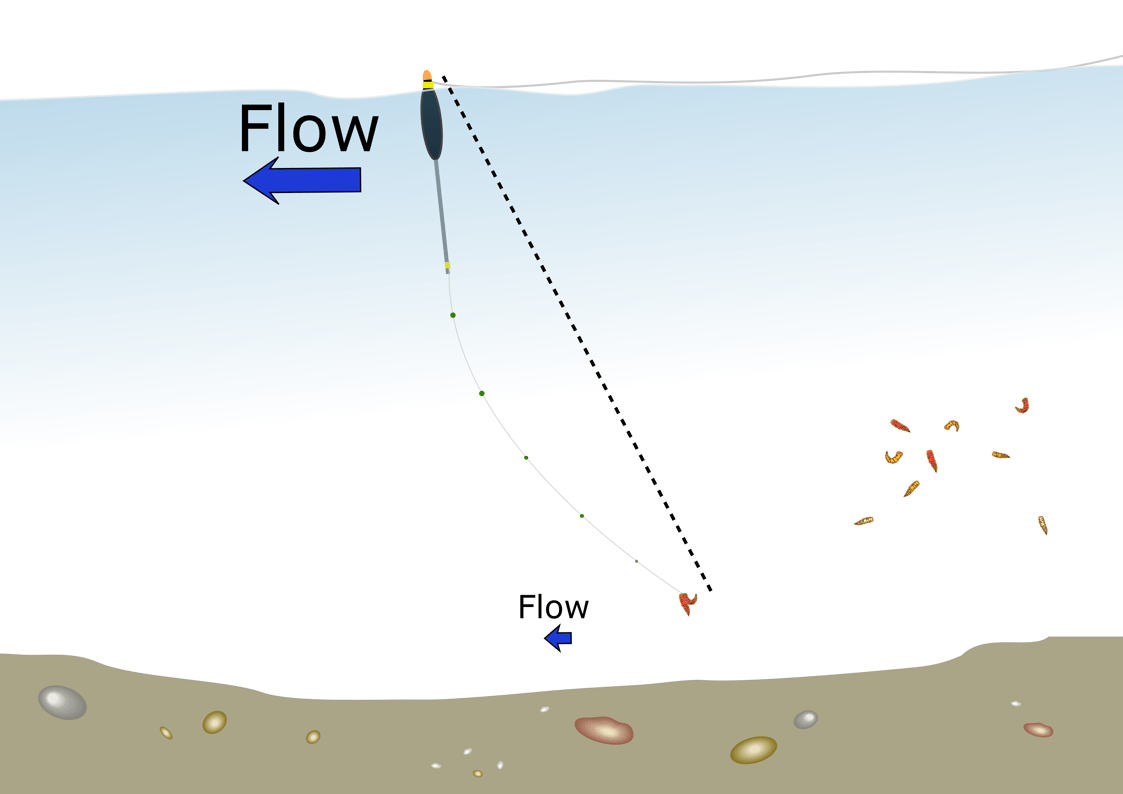
Regular-spacing of shot in a "shirt button" style - notice that the shot get smaller the closer they are to the hook
One important thing to remember for all trotting rigs is to have a "tell-tale" little shot fairly close to the hook. A distance of about 4 to 6 inches (10 to 15 cm) from the hook is usually about right. By creating a more direct tension between the shot closest to the hook and the float, bite detection ability is improved. Striking to set the hook at any hint of a bite should be coupled with sensitive rigs. This helps ensure fish do not swallow the bait and become deep-hooked.
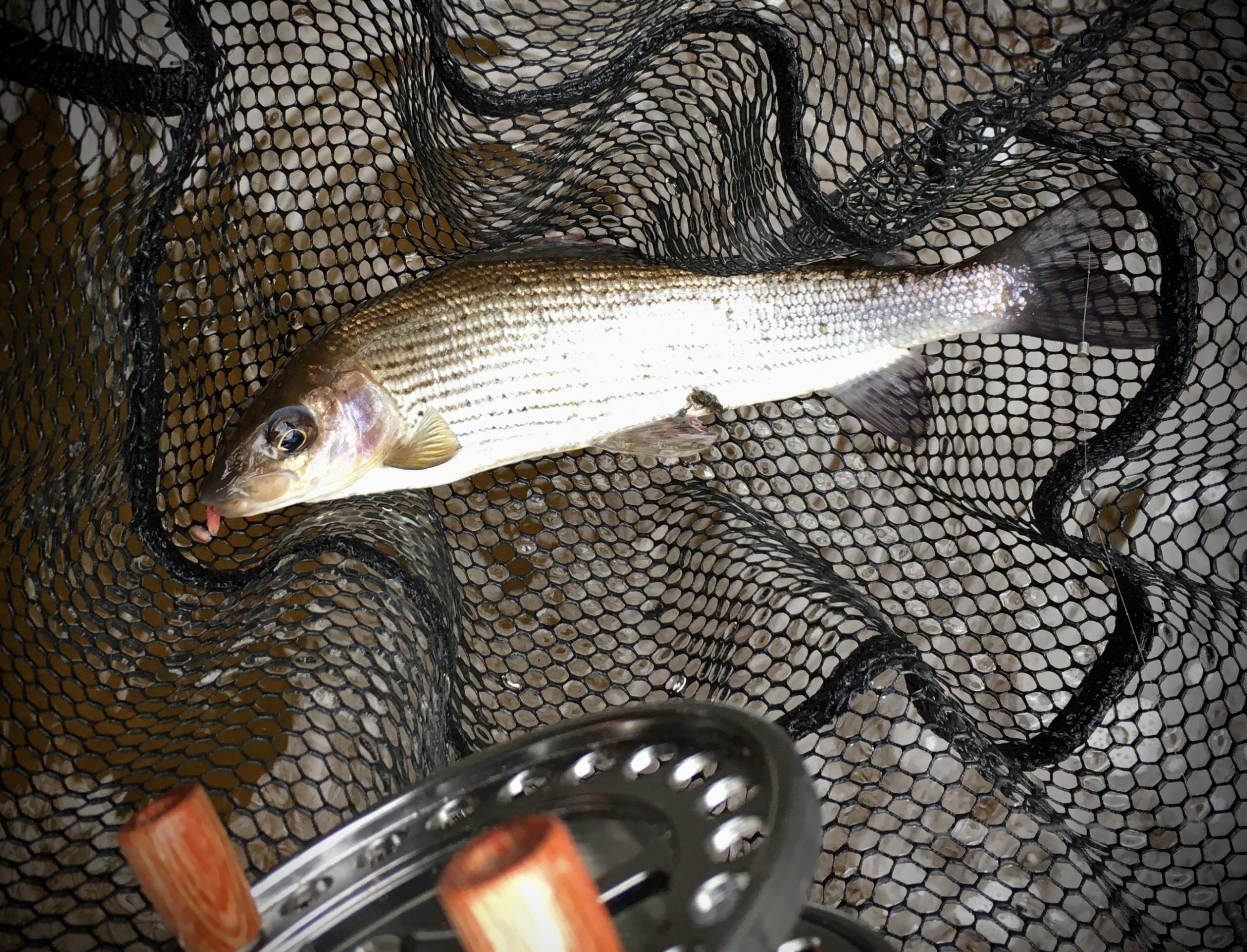
Another lip-hooked grayling on trotted maggot for John. The tell-tale shot and good drift control help you avoid deep-hooking fish
Bulk Shotting Pattern
If it is important to get the hook-bait to the feeding depth quickly, then bulk shotting patterns help. Maybe you need to pull the bait more quickly below small, shallow-feeding fish? Or perhaps the surface flow is much faster than the slower current below? Either way, bulking your shot together on the lower part of the line when trotting for grayling helps the bait to punch through the surface currents.
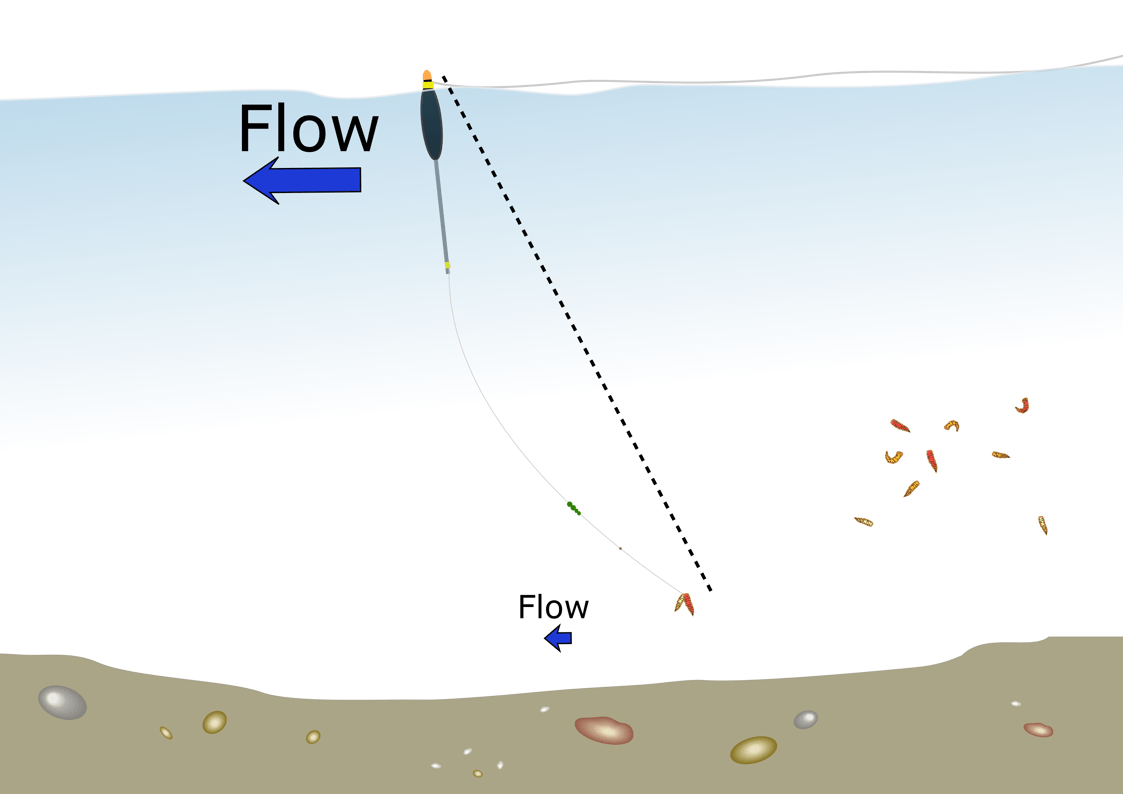
The same number of shot as before - but bulked together to pull the bait down more quickly and hold it there
The tactic of "holding back" shown in the video and discussed earlier in this article has the effect illustrated below:
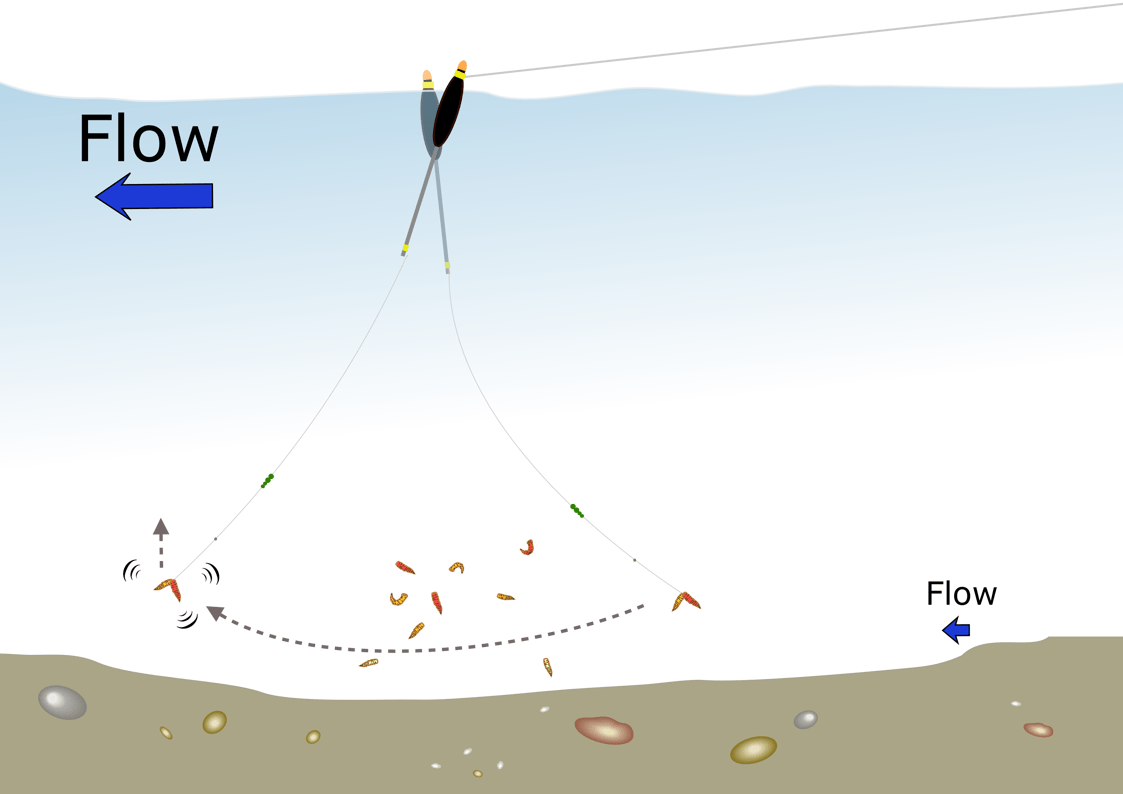
Reel Line for Grayling Trotting
Monofilament lines in the 3lb- 4lb breaking strain range are ideal for most trotting for grayling situations. When using a centrepin reel, you don't need to put tons and tons of line onto the spool. In fact, it would be a mistake to make the spool heavier than it needs to be by having way too much line loaded onto the reel. Having less line also tends to reduce the chances of the line "bedding in" and refusing to pay out smoothly when you are trotting the float below you.
Just make sure you have enough line to let you trot the float as far downstream as you want to. Then add on enough extra line to cope with a tough fight if you happen to hook into a large, strong fish.
Hook Options when Trotting for Grayling
Sharp, fine to medium-wire hooks in sizes 16 and 18 are good options for either single or double maggot. For larger baits, you might need to go up to a size 12. In all cases we'd recommend barbless hooks to help reduce the amount of grappling you'll need to do with the fish in order to remove the hook. That, coupled with proper bite indication to avoid deep-hooking, is very important in avoiding damage to wild fish like grayling.
Trotting for Grayling: Rods
Float rods, usually in lengths between 10ft and 13ft provide significant benefits by being long enough to let you hold lots of line off the water. Depending on the pace of the current and/or the species and size of fish likely to take your bait, you should choose how powerful your rod needs to be. Just don't make it so stiff that you are in danger of breaking your hook-link when you set the hook on a larger fish!
It is probably true to say that modern, light, carbon rods are a significant boon while trotting for grayling over a long session. A heavy, long rod quickly becomes annoying - as well as likely to cause you some repetitive strain injury problems!
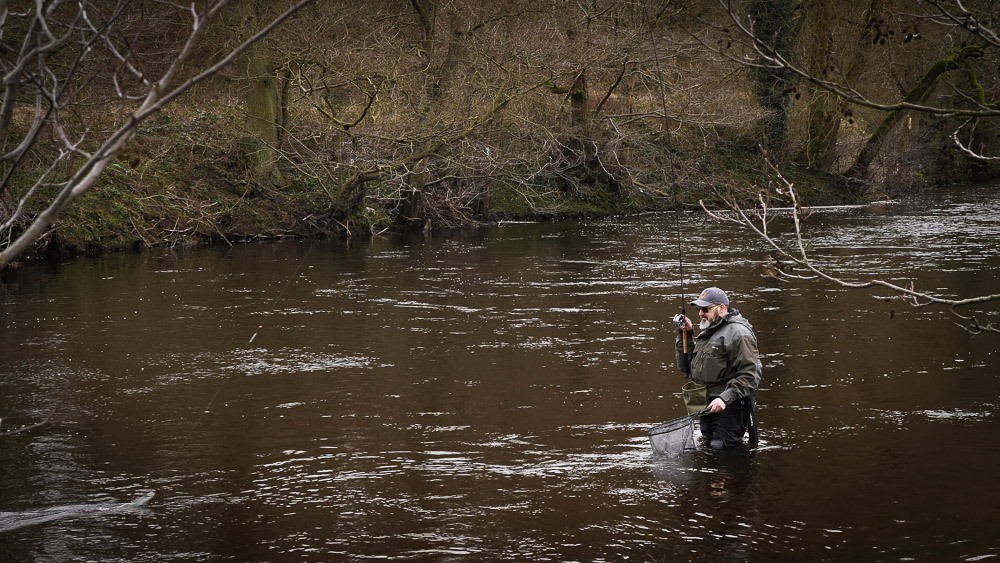
Rods that are strong enough to bring a fish upstream - and yet soft enough to avoid bouncing the hook out of a fish's mouth - are ideal
Baits for Grayling
The following is far from a comprehensive list. Instead it is a selection of simple and reliable options:
Trotting for Grayling: Round-up
From this article you can:
I hope that you've enjoyed this introduction to trotting for grayling. Remember to check whether there are any local rules or byelaws regarding whether you are able to use certain baits at particular times of the year. Beyond that, have fun trying the method if you've never used it before and smash the social share buttons if you've enjoyed this article.
Please let me know in the comments section what you liked and disliked about this article!
Paul

Excellent advice for beginners,all that you need.just be patient and trickle feed in.
This is a very clear & helpful article
Thanks very much
Thank you Steve, really glad that this was of some help to you.
Best of luck on the river,
Paul
One thing I have found confusing but important to be aware of, is the rules on bait. Some clubs ban worm but others maggots. It is vital to be clear which is permitted on the beats you are fishing. I have heard various explanations for the choice but none that made sense to me.
You’re right that this is super important David – there is a very complex mixture of National and Regional Byelaws operating above the clubs; and then the individual rights of the clubs themselves to make their own rules.
Many of those club variations will be decided via committee, so those are bound to vary from place to place – and be based on logic that might be more sound (or less so) depending on which committee decides!
Paul
if bites don’t come or slow up try a change of bait to worm or sweetcorn.
Good shout Billy – One thing that grayling seem to love is a bit of a change…That’s true when fly fishing for them too (when the bites dry up, trying the same pattern in a different colour often gets you back in the game).
Paul
This is an interesting read an watch.
Thank you Paul – (great name btw ha ha) I really appreciate you dropping by.
Paul (G)
I have always fancied trotting for grayling, might give it a go. John’s beard is getting long, I didn’t recognise hin at first.
Nice one Keith – yeah JP’s heading towards ZZ-Top territory right now hehe.
Paul
Brilliant article, thanks so much. 🙂
You are very welcome Jan – and that’s really kind of you to say.
Paul
Hi Paul – great article – wished I’d read it at the start of the winter season, when I fished this method for the first time. Love it, a great way to fish.
Andrew
Thanks Andrew – I’ll try to churn these articles out faster to get ahead of the seasons hehe!
Paul
Good stuff. Although I didn’t get much grayling fishing done this season due to the floods, one top bait you missed is sweet corn.
Ah yes – good shout on the sweetcorn Steve 🙂
Hopefully folks can learn some extra tips just like yours by reading down the comments threads on these articles.
Paul
Such an enjoyable method for winter Grayling. Great tips very clearly explained as always. Having tried this a few days ago, the “tell tale” shot and avoiding over-filling your centre-pin reel are valuable tips. Look forward to the next article!
Thanks again.
Cheers Gary – and I believe you had a bit of a “cricket score” session on the last weekend of the season with JP??
🙂 🙂 🙂
Well done and thank you for joining in the comments thread,
Paul